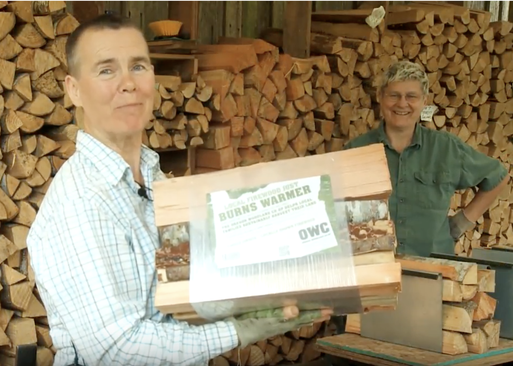 Eve & Lynn bundling Co-op firewood. Eve & Lynn bundling Co-op firewood. Eve Lonnquist can often be found working in the woods, just like her grandmother, who bought Cedar Row Farm in 1919 for $2000 and planted its namesake row of cedars. Nestled in the Nehalem River foothills, the 160-acre forest is stewarded by Eve, her two brothers and her partner Lynn Baker. The family enjoys taking care of the land and balances multiple goals, including recreation and income from timber harvest as well as providing wildlife habitat. They are FSC-certified through Northwest Natural Resource Group’s group certificate and are members of the Oregon Woodland Cooperative, selling bundled firewood to grocery stores around the Portland area. Eve and Lynn have honed techniques to protect young seedlings from the voracious deer and elk that often rest in their pasture. They’ve become practiced in DIY seedling survival while returning their stretch of the Nehalem floodplain back to shade-providing conifers as part of a Natural Resources Conservation Service project. Eve and her brothers thin young trees in their red alder stands to help the remaining trees have the space to grow and improve wood quality. “Because our grandparents were here and we are tied to the property, we have an inter-generational connection with the property that we want to maintain,” says Eve. “And we want to do right by the property.” Last year, Cedar Row Farm was Columbia County's Tree Farm of the Year. This 4-minute video by the American Tree Farm System and U.S. Forest Service celebrates the forest’s history and management. To Eve, being a certified tree farm “means that I’m managing the property for the health of the property and for income.” Originally appeared in Northwest Natural Resource Group Newsletter, June 8, 2018 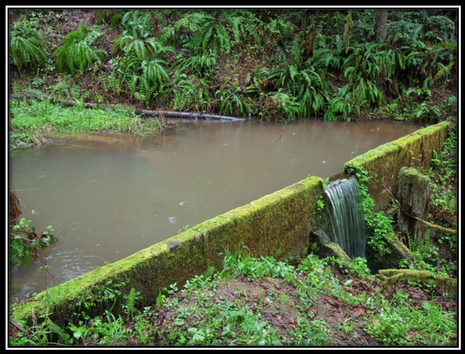 By Marc Ahrendt We recently completed our first forest management plan. Initially, our focus was just to get a better understanding of the trees. Getting assistance from a professional allowed us to time to also get a better understanding of other property aspects, and how those aspects relate to each other and the trees. I will highlight two of the “other property aspects” that we did not anticipate would get much attention in our plan. The first was doing research on the dam pictured above. It was surprising to be able to download (from www.oregon.gov/owrd) the original permit application for the dam and associated water rights! The 1928 permit included the estimated construction costs ($1250), project timelines (built within 2 years and water use within 3 years), and some physical dimensions (diameter of outlet/supply pipe at 1.5 inches). Learning about the dam has led to learning/thinking about other water related aspects, like water quality and testing. The second was identifying our primary objects for the property …why did we buy? We had to turn our feelings/dreams/ambitions into several sentences. One interesting component of that was setting property restrictions (no hunting, no littering, no burning, and no chemicals). The twist of thinking not just about what we wanted, but what we did not want, helped us greatly with our overall forest management plan. And yes, I spend much time pulling Scotch Broom and cutting back Himalayan blackberry …yet that makes me take a closer look at the ground (found old logging cables but no luck finding antler sheds). 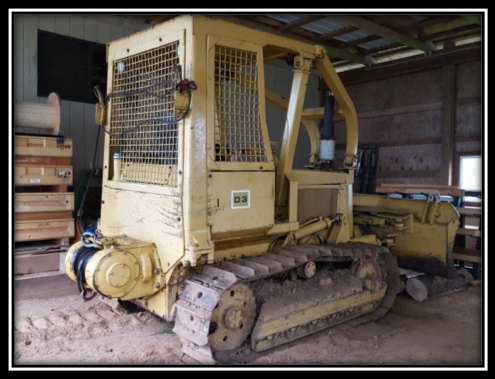 By Marc Ahrendt As a new small woodland property owner, we need to acquire equipment to meet our forest management plan objectives. A recent bulldozer acquisition was an unexpected opportunity. It will greatly help us with road maintenance and be available for miscellaneous tasks (like some small logging operations in steep areas of our property). Three appealing features of this bulldozer are the following: 6-way blade; winch with steel cable (made later upgrade to synthetic rope); and a beefy cage/ROPS (RollOver Protection System). The bulldozer is a “nice to have”, but our log splitter has unexpectedly become a “must have”! It used to be so tough to get help splitting firewood. Now all I have to do is start the SuperSplit and the help just appears. No surprise that OWC wanted to be a distributor for SuperSplit …as well as for Logrite. Neither company has disappointed me with their quality products. 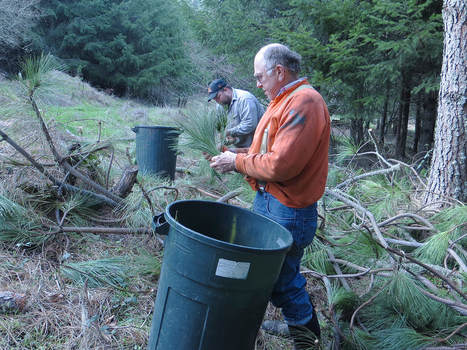 Collecting fresh Ponderosa pine needles for oil distillation Collecting fresh Ponderosa pine needles for oil distillation By Jim Merzenich, Oak Basin Tree Farm, Brownsville, OR Several years ago OWC helped to develop a market for essential oils derived from conifer needles. In 2012 the cooperative had a Woodland Fair at our tree farm where the process for extracting these oils using steam distillation was demonstrated. Together with my late friend Dave Bateman, I thus purchased a still. The process is to collect and grind the needles then run them through the still. The needle oil evaporates with the steam and is condensed back to a liquid. The oil can then be easily separated because it floats on the water. A one hundred and fifty pound batch of ground needles generally produces from 3 to 8 ounces of oil. We currently produce and sell oil from ponderosa pine, Douglas-fir, incense cedar, western red cedar, noble fir, and grand fir. This oil is sold under both the Oregon Forest Canopy label and our private Oak Basin tree farm label. When I thin and prune my conifer stands I am now collecting needles to run in my still. Oils are available for purchase online through Oregon Heartwood and at New Seasons Markets in the Portland area. A small firm in Eugene called Broom Magic makes and sells traditional brooms using real broom corn and nineteenth century broom-making equipment. The handles for these brooms are harvested from our tree farm and several other farms in Linn County. The handles are manufactured from 6’ long sticks that vary from about ½ to 2 inches in diameter. These sticks are cut in the winter when the plants are dormant and are then kiln dried with the bark on. Favorite species for handles are hazel, cascara, and cherry. While most sticks are relatively straight defects such as unusual crooks or animal gnaw marks can add character and value to a finished broom. We are paid for these sticks when we deliver them to the kiln. Other products such as bundled firewood, holiday boughs, and wood craft with the Heartwood label are now produced and sold by OWC members. I am in the process of training my 18 month-old pup to help me find and market truffles from our young Douglas-fir stands. Many other opportunities exist to derive added income from your farm. The Oregon Woodland Cooperative may help you find that niche market. Happy tree-farming and good-luck chasing your dream.
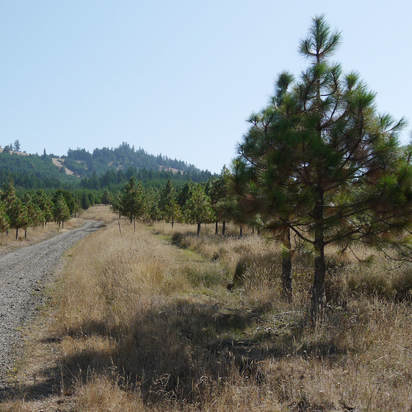 Native Ponderosa pine planted at Oak Basin tree farm Native Ponderosa pine planted at Oak Basin tree farm By Jim Merzenich, Oak Basin Tree Farm, Brownsville, OR Prior to European settlement frequent fires burned across Oregon’s western valleys and surrounding foothills. These fires maintained open stands of hardwoods, pine, and fir along with wet and dry prairies. After a wind or other disturbance event, fire cleared out the debris and undergrowth and provided a seed bed that enabled conifers to regenerate and thrive. Areas that are logged and not properly reforested, or areas of untended farmland, now suffer a different fate. Non-native grasses quickly invade the site. These grasses utilize soil moisture in our dry summers and prevent conifer tree seedlings from becoming established. Exotic invaders such as English hawthorn, Himalayan blackberries, and Scotch broom then move in making these sites unproductive both to society and wildlife for decades. Our valley ecosystems are clearly out of sync and are no longer capable of restoring themselves. Despite forest protection laws many areas previously logged remain brushed over and unproductive; other parcels are logged with no plans for management; and farmland parcels are still being neglected. To the rescue comes the tree farmer. We typically buy land that has a history of abuse because we cannot afford to buy well-managed land with merchantable saw-timber. First the area must be cleared of brush in a process called site-preparation. After planting the appropriate tree species we control grasses and weeds around seedlings until the trees are “free to grow”, hopefully within five years. Even with our best efforts we are not always successful but learn from our mistakes. With deer browsing the leaders and meadow voles girdling the stems it’s soon time to do a pre-commercial thin. All of these activities incur costs which are not recoverable until our stands become merchantable. After 20 to 30 years we may finally have a commercial thin which provides our first “timber” related income. Tree farmers do not purchase land with the intent to lose money. Management costs may be overwhelming, however, before you send your first load of logs to a mill. I joined the Oregon Woodland Cooperative (OWC) in search of ways to earn income while waiting for my trees to mature. This investment in OWC has paid off handsomely. 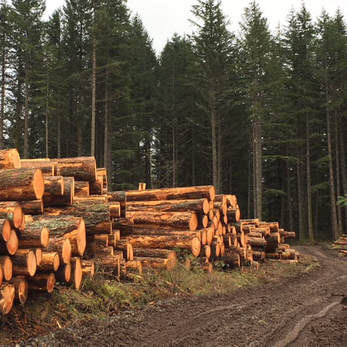 Thinning project in 2017 Thinning project in 2017 William Ingram was seven years old when he arrived in Oregon with his family in 1854. They had taken a ship from Maine to New York, then to Panama, crossed the isthmus by mule to the Pacific, boarded a ship from there to San Francisco, then another ship to Oregon City, and an ox team south to the Willamette Valley. Their Donation Land Claim, in the hills between Sodaville and Brownsville, Oregon, had only a few large conifers and a grove of oaks – the surrounding grassland was selected for their farm. The native people had burned it each year, creating an oak savanna. A century and a half later, the giant fir where the family met Blackhawk, when he would escape from the Grand Ronde reservation, is now just a rotting stump. The other giant Douglas-fir and incense cedar trees from those days are still there, sentinels of another time. When the family quit farming this hill property, sheep from the valley were grazed here for summer pasture. Sometime in the 1930’s, as grazing decreased, young fir and cedar began to cover the hills, seeded by those giant trees. The firewood we produce for OWC was thinned from this stand, grown where William, our great grandfather, grew up. We hope you enjoy it as much as we do. 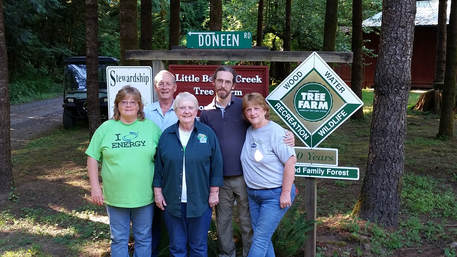 Richard Hanschu, Anne Hanschu and our three adult children (L-R): Kristine, Richard Duane, and Amanda. Richard Hanschu, Anne Hanschu and our three adult children (L-R): Kristine, Richard Duane, and Amanda. Little Beaver Creek Tree Farm began in 1956 with a purchase of 141 acres by Byron and Marguerite Doneen. Later, another 56 and 15 acres parcels were added for a total or 212 acres to become the Wildcat Unit. In 1973 another 212 acres were purchased called the Meecham Unit. The final purchase of land was in 1986 with 70 acres near Manning. This brought the total number of acres to 494. Management includes pre-commercial thinning, commercial thinning, pruning, and brush release. In 2016 we did an unusual harvest of 173 utility poles over a 36 acre area on the Wildcat Unit. Richard and Anne Hanschu are second generation managers, The third generation is involved in the management decisions by virtue of corporate share ownership and Board of Directors positions. The fourth and fifth generation enjoys the trees by means of summer trips and help in the woods. The tree farm is certified under the American Tree Farm System (ATFS) and Forest Stewardship Council (FSC). Richard and I have created an outdoor forest laboratory with trails to various educational stations giving an insight to those outside the forestry circle as to what is involved in tree farming. 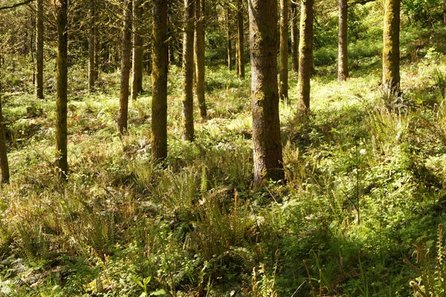 From RIdgeback Tree Farm About 10 years ago, we purchased a small tract of 25-year old Douglas-fir from the neighbor. The stand was about 25 years old at the time and many of the trees were tall, spindly and stressed as a result of being crowded too close together. The understory was pretty barren since little light penetrated to the forest floor, It was self-mulched with needles and twigs. We knew something needed to be done to improve the health of the forest stand. With help from the forester at our local soil and water conservation district, we made some simple measurements of the stand. He prescribed thinning the stand to reduce crowding, improve the health of the remaining trees, and encourage more plant diversity for wildlife. That summer we starting thinning our the poorest trees with the help of a fellow OWC member. All the wood harvested eventually ended up packaged in the bundled firewood that the Co-op sells. And we did a second, lighter thinning a few years later that also produced firewood for OWC. It’s now four years after the last harvest, and we are starting to see the positive effects it had on the stand. Just in terms of biodiversity, there’s been a big increase in the number and variety of understory plants. This spring, we’re seeing seedlings of many native shrubs such as blue elderberry, snowberry, dwarf Oregon grape, vine maple, etc., plus lots of swordfern and wildflowers. All have naturally seeded-in, and will provide food and cover for wildlife. Plus the remaining Doug-fir trees are doing well now they have more room to grow. 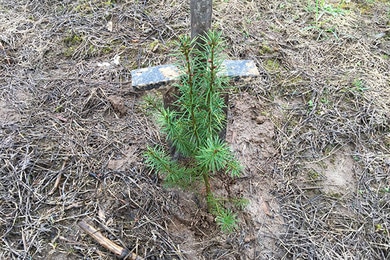 New Doug-fir seedling New Doug-fir seedling From Ridgeback Tree Farm: The cycle of renewal on our tree farm begins early, in February when it's still cold and wet in western Oregon. It's the time of year when we plant out tree seedlings to create new, or supplement existing, forests. This year we bought a mix of both hardwood and conifer seedlings: Bigleaf Maple, Doug-fir, Western Hemlock, Red Alder and Incense Cedar; about 200 in all. We got good seedlings through the Washington Co. Small Woodlands Association and Brooks Tree Farm. We're creating a new, mixed-species stand on ground formerly in Christmas trees. There are groups of conifers, including the species above plus Western red cedar and Ponderosa pine, with maple and red alder planted around the edges. The conifers will someday be harvested for timber and the hardwoods thinned to for firewood, while the diverse stand provides habitat for wildlife. |

